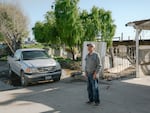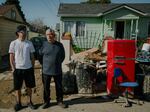
Climate activist and Pajaro Valley High School senior Denia Escutia, 18, looks around her mud-coated bedroom in Pajaro, California on March 24, 2023. Days earlier, residents began returning to their homes after a levee breach flooded the area several weeks earlier.
Kori Suzuki / Kori Suzuki / KQED News
The street in front of Antonio Hueso’s two-story, yellow-daisy-colored home in Pajaro turned into a 5-foot-deep muddy river in the early morning hours of March 12, submerging his baby-blue Ford F-150 truck and flooding his first floor.
“In Pajaro, nothing is going to change, because poor people live here,” said Hueso, 72, a retired farmworker, recounting more than three decades of requests from the community for local, state and federal officials to fix the aging levee on the Pajaro River, 4 miles upstream of his town.
Several weeks after the levee failed — once again — forcing thousands of Pajaro residents to flee in the predawn darkness as water rushed toward their lower-income community in northern Monterey County, Hueso is beginning the arduous task of renovating his flood-damaged home. Over the nearly five decades he’s lived here, this is now the second time he has had to do this — having already lived through an equally devastating flood in 1995.
Officials say a major levee update could begin as soon as 2025, but Hueso questions whether those plans will account for the changing climate and the increased frequency and ferocity of storms expected.

Antonio Hueso, 72, stands in the driveway of his home in Pajaro, California after floodwaters in mid March flooded the first floor of his home and submerged his truck. He's considering repairing his home of 48 years and selling.
Kori Suzuki / Kori Suzuki / KQED News
He is now considering leaving.
“I’m going to fix my house, and when people forget about the flooding, I will sell my house and move to Madera or Fresno,” he said.
‘Nowhere near’ a worst-case scenario
Climate scientists warn that what Californians have lived through in recent months is just a preview of what’s to come, with exponentially worse flooding predicted in future years.
“As disruptive as this year’s events have been, we’re nowhere near to a plausible worst-case storm and flood scenario for California,” said UCLA climate scientist Daniel Swain.
Before cities and farmland dominated the terrain, much of California was perpetually wet, with a vast system of rivers and waterways running through its core. Catastrophic floods reshaped the landscape every few centuries.
Swain is unequivocal about the links between a warming climate due to the burning of fossil fuels and the significant increase in extreme flooding. A 2022 study Swain co-authored found that the warming climate has already doubled the probability of a megaflood caused by a string of extreme atmospheric rivers.
Every degree of new warming increases that likelihood even more, he said.
In other words, what was once considered unlikely to happen in our lifetimes “has become quite likely,” Swain said, adding that he wouldn’t be surprised if as many as four megafloods happened just in this century.
“We’re not necessarily talking about 100 years from now. We’re talking about the next 20 or 30 years,” he said. “We’ve gotten a taste of widespread flooding, but I do think it’s only a taste.”
California has already been hit by more than 30 atmospheric rivers since October. But in order to be categorized as an extreme scenario, those weather events would have had to take place in rapid succession, with little or no time in between.
This year, by contrast, there were breaks of up to a month between each of the storms. And despite the havoc they wreaked, none were technically considered “extreme,” Swain said.
“This winter, we’ve gotten lucky, believe it or not, because things could have been significantly worse than they were,” he said. “It is possible to have years where there are multiple atmospheric rivers in a row that are much stronger than what we saw at any point this year.”
Swain said the recent storms dropped only about half the precipitation and less than a quarter of the runoff than in the “plausible worst-case scenario” he describes in his study. The resulting “megaflood” conditions, he said, would cause “widespread levee failures, and not just levees protecting primarily agricultural areas, but potentially levees that protect major urban areas.”
A KQED analysis of the National Levee Database found that only 10% of the nearly 600 levees in the greater Bay Area have a flood-risk rating. The small percentage that do include the breached levee on the Pajaro River, which is rated “moderate,” as is one on the Salinas River, which also failed, in January, displacing thousands. Other levees rated “moderate,” in more urban areas like San José, also are at risk of significant flooding.
“We’ve definitely gotten a taste in some areas of what a much lesser version of this would look like,” Swain said. “But we need to be preparing for and stress-testing our infrastructure for much greater events than the ones you’ve seen this year.”
Flood modeling
California is taking Swain’s predictions seriously by potentially funding a flood-modeling project — in partnership with Swain and the Oak Ridge National Laboratory — to gain a better understanding of the impact an extended series of extreme storms would have on existing infrastructure, like levees.
“This is a flood model that would resolve the flood risk at one corner of someone’s house versus another corner, for example,” Swain said. “That’s how detailed it would be for the whole state.”

Armando Alvarado, 22, and his father Jesús Valtierra, 52, stand outside their home in Pajaro, California on March 24, 2023. Alvarado worries about how costs to repair the damage will affect his family's rent in a place where a one-bedroom apartment can cost as much as $2,800.
Kori Suzuki / Kori Suzuki / KQED News
The project involves recording a host of factors, including soil conditions, river flows, forecasted precipitation, real-time snowmelt and runoff, in an effort to calculate the extent of flooding that could result from storms of various intensities.
Doing so could also help predict which parts of the state are at greatest risk of flooding and who should evacuate, said Michael Anderson, the state’s climatologist.
“The other thing we can do is start saying, ‘Wow, if that happened, how do we recover?”’ Anderson said. “How do we take that really horrible situation and try and turn it into a chance to maybe rethink how we do some things?”
But Anderson notes the project, which could take up to a year to complete and would cost in the ballpark of half a million dollars, is coming too late for the many thousands of people already displaced by floods this year.
“Unfortunately, Mother Nature kind of beat us to the punch here,” he said. “But we’re trying to develop a capability that can work with the scenario to help us better understand how to recognize when things are scaling up so that you get the right level of response dialed in. And it’s a tool we don’t have right now.”
Living in the shadow of an aging levee
For young people like Armando Alvarado, who now lives in the shadow of a broken levee, the climate crisis is all too real. A week after floodwaters covered Pajaro, the 22-year-old returned home to find his garage coated with a thick layer of sticky, putrid mud — even as the rest of the elevated home his family rents was unscathed.
But the wet mud in the garage ruined a number of family heirlooms, including his collection of red, white and black ostrich-leather ranchero boots.
“They were emotional gifts from my family in Mexico, like uncles that passed away,” he said.
Alvarado said he’s worried about how the damage from the flood, and the remodeling it will require, will affect the price of rent in an area of California where a one-bedroom apartment can cost as much as $2,800.
Denia Escutia, a high school senior who lives a few blocks south of Alvarado, woke up early in the morning on March 12 to the sound of water pouring into Escutia’s purple bedroom adorned with K-pop posters.
“I touched my feet to the rug, and the rug was wet,” said Escutia, 18, who prefers to not use any pronouns. Escutia’s entire house had filled with a thin layer of smelly, muddy water.
“I woke up my dad, and we started unplugging a bunch of stuff,” Escutia said.
Now, weeks after the flooding and subsequent evacuation, the young climate activist is questioning whether or not to see a future in Pajaro because of the obvious, familiar risks — including droughts, heat waves and flooding — that will likely only get worse with a warming climate.
Escutia, whose hometown is Pajaro and who dreams of living safely on a nearby hill, surrounded by family, fears Pajaro has no future because of climate change and the decisions made by those in power that devalue the people living here.
“I think Pajaro deserves climate justice,” said Escutia. “I call this my home, but is it really my home if they don’t want to help us?”
Copyright 2023 KQED.